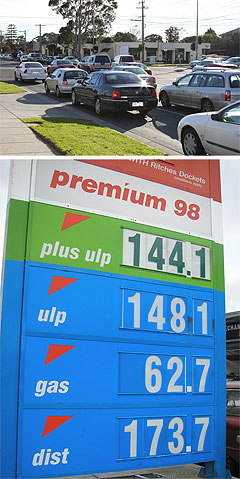Make / Model Search
News - General News - FuelsLiquid gas injection breakthroughIt's a gas: LPG remains Australia's least expensive automotive fuel. LPG Liquid Injection tech to rival petrol engine consumption in Oz within a month24 Jun 2008 By JOHN MELLOR THE Australian car industry and Kevin Rudd’s struggling ‘working families’ could soon benefit from a completely new form of LPG technology that improves the fuel economy of LPG cars and significantly improves emissions. Known as LPG Liquid Injection, the technology is said to produce fuel economy for LPG cars that is close to the petrol equivalent for the same car. The exhaust emissions are also said to be significantly better than petrol or diesel vehicles because using liquid injection creates a much more complete fuel burn than using LPG vapour. The imported liquid injection system, called JTG (Just Think Green), is expected to go on sale at LPG conversion workshops in late July. Conversions will cost about $300 to $400 more than current conversions. The early focus will be in Falcons and Commodores before being rolled out to other makes and models. It will be a prelude to the release of Australian-developed liquid injection LPG technology later this year, although that timetable is now in doubt because of the Rudd government’s suspension of the Commercial Ready grants scheme in the May budget. The attraction of the LPG vehicle is that the price of LPG is around $1 a litre less that petrol. Last year, of the 110,000 LPG conversions performed in Australia, around 85,000 were for private motorists taking advantage of the $2000 federal government grant. Most conversions use gas vapour and are dual-fuel – petrol and LPG. These are a compromise because the engine compression ratio can be optimised for LPG. Ford overcomes this issue by optimising the Falcon’s 4.0-litre straight-six engine for gas only and now sells about 30 per cent of Falcon volume as E-Gas-powered. But this engine still suffers in terms of fuel used compared with its petrol equivalent because LPG does not have quite the same zest as petrol and LPG cars therefore have to use more fuel to cover the same distance. For example, the dedicated E-Gas XT Falcon consumes 14.9L/100km compared with the 10.5L/100km for the petrol version.  Dual-fuel is even less efficient. A dual-fuel Commodore Omega uses 16.0L/100km compared with the petrol-only engine at 10.8L/100km The holy grail of the LPG industry therefore has been to develop technology that achieves parity with the fuel economy of the petrol engine. The new liquid injection system has closed the gap to just five per cent more LPG used per litre than for petrol. Dual-fuel is even less efficient. A dual-fuel Commodore Omega uses 16.0L/100km compared with the petrol-only engine at 10.8L/100km The holy grail of the LPG industry therefore has been to develop technology that achieves parity with the fuel economy of the petrol engine. The new liquid injection system has closed the gap to just five per cent more LPG used per litre than for petrol.That equates to an estimated 11L/100km if it was fitted to the Falcon. This is a massive breakthrough. Estimates by GoAuto suggest that such a system would save an XT Falcon or Commodore Omega owner about $2000 over 20,000km (see table). The liquid injection LPG technology fitted to the petrol engine of a Toyota Camry Hybrid (using Canadian fuel economy figures as a guide) would, GoAuto estimates, save a driver nearly $2500 dollars over 20,000km compared with a standard Camry. In fact, a driver of such a Camry could cover 20,000km for around $800. The difference between liquid injection and vapour injection is that the traditional system turns the liquefied gas to vapour before injecting it into the intake manifold. The liquid injection system takes the liquid right up to the injectors and these produce a droplet of LPG liquid into the intake manifold just as the engine is sucking in the air-fuel mix. What is clever about this is that LPG under pressure turns to liquid. In fact, a feature of the storage of LPG is that by compressing the gas, 240 times more gas fits into a tank in liquid form than as a gas. The technology does the reverse. When the droplet of LPG liquid is squirted from the injector into the manifold (towards the back of the inlet valve) because it is no longer under pressure it expands 240 times into gas and all but freezes the incoming air - which is ideal for improving power, economy and emissions. All those who remember how well cars with carburettors ran on very cold nights will know that the cold air made the engine run better than ever before with better power and fuel economy. The imported JTG system is being distributed by Melbourne-based Australian LPG Warehouse, which is paying licence fees to the holder of the Australian patents to the technology, LPG-Liquid-Inject Ltd (LPGLI), an unlisted public company based at the Melbourne Docklands Science Park. The chairman and CEO of the Docklands Science Park, John Martin, said his company was waiting for deliveries of pre-production injectors prior to starting production for the Australian market. He said that there could be a delay in getting the local system into the market due to changes by the Rudd government to innovations funding. He said his company was relying on a Commercial Ready development grant of $400,000 from the government to get his local technology into production. He said that the cancellation of the program applied even to companies that had their application into the government 12 months ago. He said there is no program at the moment and the company has been told by Canberra it could be the end of 2009 before any funding could be expected from a new program and that the company might have to issue more shares now that the Rudd government withdrew the Howard government’s innovations initiative. Mr Martin said that he hoped to attract the attention of GM Holden to assist with developing the technology and the engine management system now that Holden has confirmed that it was going to market a dedicated-LPG Commodore in Australia. He said that Holden could use his system since the LPG supply agreement with General Motors and Impco Technologies had expired two years ago. He believed that his technology would qualify for funding under the $500 million Green Car Innovation Fund if it was used by GM Holden, Ford or Toyota to develop and optimise local dedicated-LPG liquid injection engines. LPG Liquid Injection: the PG/Fuel Study:
# Liquid injection LPG, assuming five per cent decrease in fuel economy compared to equivalent petrol engine * Camry Hybrid estimates based on Government of Canada EnerGuide Fuel Consumption Guide |
Click to shareGeneral News articlesResearch General News Motor industry news |









Facebook Twitter Instagram